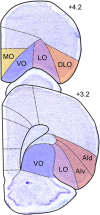Defining an orbitofrontal compass: Functional and anatomical heterogeneity across anterior-posterior and medial-lateral axes
- PMID: 34060873
- PMCID: PMC7613671
- DOI: 10.1037/bne0000442
Defining an orbitofrontal compass: Functional and anatomical heterogeneity across anterior-posterior and medial-lateral axes
Abstract
The orbitofrontal cortex (OFC) plays a critical role in the flexible control of behaviors and has been the focus of increasing research interest. However, there have been a number of controversies around the exact theoretical role of the OFC. One potential source of these issues is the comparison of evidence from different studies, particularly across species, which focus on different specific sub-regions within the OFC. Furthermore, there is emerging evidence that there may be functional diversity across the OFC which may account for these theoretical differences. Therefore, in this review we consider evidence supporting functional heterogeneity within the OFC and how it relates to underlying anatomical heterogeneity. We highlight the importance of anatomical and functional distinctions within the traditionally defined OFC subregions across the medial-lateral axis, which are often not differentiated for practical and historical reasons. We then consider emerging evidence of even finer-grained distinctions within these defined subregions along the anterior-posterior axis. These fine-grained anatomical considerations reveal a pattern of dissociable, but often complementary functions within the OFC. (PsycInfo Database Record (c) 2021 APA, all rights reserved).
Figures



